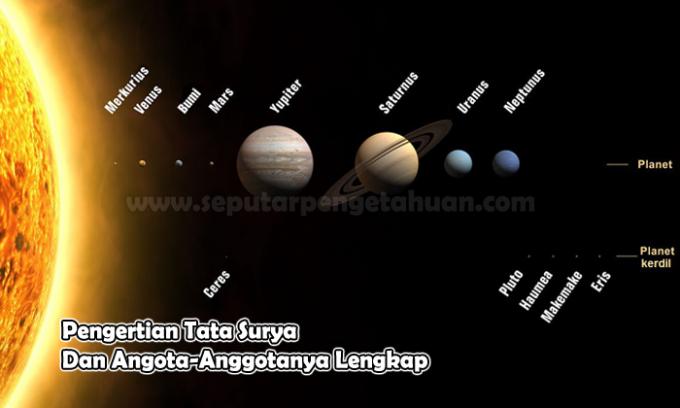Understanding the Solar System and Members of the Solar System (Complete Discussion)
Understanding the Solar System and Members of the Solar System (Full Discussion) – Briefly and completely aboutknowledge.com will explain about the meaning of the solar system and the members of the solar system. Here's the explanation.
Table of contents
-
Understanding the Solar System and Members of the Solar System (Full Discussion)
- Understanding the Solar System
-
Members of the Solar System
- Sun
- Planets
- Comet
- Share this:
- Related posts:
Understanding the Solar System and Members of the Solar System (Full Discussion)
Let's discuss the meaning of the solar system first carefully.
Understanding the Solar System
The solar system is the arrangement of celestial bodies consisting of the sun, planets that revolve around the sun, asteroids, comets, and other celestial bodies. Celestial bodies that emit light are called stars.
Members of the Solar System
The members of the solar system include:
Sun
The sun is a celestial body that can emit its own light so it is also called a star. The sun is the closest star to the earth. The sun is also the center of the solar system because the planets move around it. Every second the sun is able to emit about 5,6,1027 cal of energy.
Sun Arrangement consists of:
- Sun Core The place where the fusion reaction takes place from hydrogen nuclei to helium nuclei.
- Photosphere This layer always emits light, looks like gas in motion and can be seen with a telescope.
- Chromosphere This layer is outside the photosphere and is also known as solar atmosphere.
- Corona This layer is above the chromosphere and is the outermost atmosphere of the sun.
Planets
Planets can be grouped into three, namely:
1. Based on the earth as a barrier, it consists of the inferior planets (Mercury, Venus) and the superior planets (Mars, Jupiter, Saturn, Uranus and Neptune).
2. Based on the asteroid belt as a barrier, consisting of the inner planets (inner planets); Mercury, Venus, Earth. And the outer planets; Saturn, Uranus and Neptune.
Also Read:Wave Period: Definition, Frequency, Velocity, Magnetic Field and Oersted's Experiment
3. Based on the size and composition of the constituent materials, it consists of terrestrial planets which are planets in the form of rocks (Mercury, Venus, Earth, Mars), and the jovian planets, which are large planets composed of ice and hydrogen gas, consisting of: Jupiter, Saturn, Uranus, Neptune.
Circulation of the Planets
- Revolution. It is the rotation of the planets around the sun. The cause of the revolution is the sun's gravitational force.
- Orbit. It is the orbit or path of the planets around the sun.
- Circular Field. It is a flat plane in which the planets revolve around the sun. The plane of the planet's orbit is called the ecliptic plane.
- Planetary Circular Direction. When viewed from Earth's north pole, the inner planet's orbit rotates counterclockwise.
- Time of Revolution. That is the time it takes the planet to make one revolution.
- Satellite as a Planetary Companion. Satellites are planetary companions. Satellites always revolve around their planets in the same direction as the planets. Our earth has one planet, the moon. Almost every planet has its own satellite.
- Asteroids. These are small planets that revolve around the sun. The asteroid's path lies between the orbits of Mars and Jupiter. No other asteroid trajectories have been found in our solar system. Asteroids are much smaller than planets.
-
Meteors and Meteorites. Meteoroids are rocks found in interplanetary space. Meteors are celestial bodies that glow because they move quickly and rub against the air. While meteorites are meteors that fall and reach the earth. There are 3 types of meteorites, namely:
Metal meteorite containing the elements nickel and iron, rock meteorite which has silicon and mixed meteorite which has metal and silicon elements.

Comet
Comets are celestial bodies that revolve around the sun in an elliptical orbit. Comets are formed from the frozen elements of gas and dust.
Also Read:Air Pressure: Definition, Types, Measuring Instruments, Formulas and Factors That Affect It
Comet parts consist of: core, coma, hydrogen cloud, and comet tail. When approaching the sun, comets form tails that point away from the sun. On the other hand, if you move away from the sun the tail of the comet will disappear Comet tails always move away from the sun. The most famous comet is Halley's comet which appears every 76 years. This comet last appeared in 1986.
That's a short and concise explanation of Understanding the Solar System and Members of the Solar System (Full Discussion), hopefully useful for readers and thank you so much.
